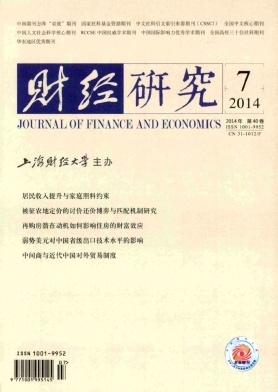投资者异质信念、股权融资现金流与企业过度投资——来自中国A股的经验证据
财经研究 2014 年 第 40 卷第 07 期, 页码:86 - 96
摘要
参考文献
摘要
文章在限制卖空的背景下,利用改进的股权融资模型和投资者迎合理论模型,理论分析并实证检验了投资者异质信念与企业过度投资行为之间的关系。研究表明:投资者异质信念既通过促使企业管理者迎合投资者而直接加剧企业过度投资,也通过影响企业的股权融资现金流而间接促进其过度投资;投资者异质信念对私营企业过度投资的影响仅体现在投资者迎合渠道,而对国有企业的影响则主要反映在股权融资渠道;两种作用渠道都存在于成长性企业中,而不存在于非成长性企业中。
[1]陈国进,胡超凡,王景.异质信念与股票收益——基于我国股票市场的实证研究[J].财贸经济,2009,(3):26-31.
[2]陈国进,张贻军.异质信念、卖空限制与中国股市的暴跌现象研究[J].金融研究,2009,(4):80-91.
[3]花贵如,刘志远,许骞.投资者情绪、企业投资行为与资源配置效率[J].会计研究,2010,(11):49-55.
[4]刘端,陈收.中国市场管理者短视、投资者情绪与公司投资行为扭曲研究[J].中国管理科学,2006,(2):16-23.
[5]孟卫东,江成山,陆静.基于内生后验异质信念的资产定价研究[J].管理工程学报,2010,(3):66-74.
[6]史永东,李凤羽.卖空限制、意见分歧收敛与信息披露的股价效应——来自A股市场的经验证据[J].金融研究,2012,(8):111-124.
[7]王霞,张敏,于富生.管理者过度自信与企业投资行为异化——来自我国证券市场的经验证据[J].南开管理评论,2008,(2):77-83.
[8]余明桂,夏新平,邹振松.管理者过度自信与企业激进负债行为[J].管理世界,2006,(8):104-112.
[9]张峥,刘力.换手率与股票收益:流动性溢价还是投机性泡沫?[J].经济学(季刊),2006,(3):871-892.
[10]周伟贤.投资过度还是投资不足——基于A股上市公司的经验证据[J].中国工业经济,2010,(9):151-160.
[11]Baker M,Stein J,Wurgler J.When does the market matter?Stock prices and the investment of equitydependent firms[J].Quarterly Journal of Economics,2003,118(3):969-1006.
[12]Barron O.Trading volume and belief revisions that differ among individual analysts[J].The Accounting Review,1995,70(4):581-597.
[13]Bayar O T,Chemmanur J,Liu M H.A theory of equity carve-outs and negative stub values under heterogeneous beliefs[J].Journal of Financial Economics,2011,100(3):616-638.
[14]Boehme R,Danielsen B,Sorrescu S.Short-sale constraints,differences of opinion and overvaluation[J].Journal of Financial and Quantitative Analysis,2006,41(2):455-487.
[15]Chen C R,Lung P P,Wang F A.Stock market mispricing:Money illusion or resale option?[J].Journal of Financial and Quantitative Analysis,2009,44(5):1125-1147.
[16]Chen J,Hong H,Stein J.Breadth of ownership and stock returns[J].Journal of Financial Economics,2002,66(2-3):171-205.
[17]Diether K,Malloy C,Scherbina A.Differences of opinion and the cross section of stock returns[J].Journal of Finance,2002,57(5):2113-2141.
[18]Garfinkel J,Sokobin J.Volume,opinion divergence,and returns:A study of post-earnings announcement drift[J].Journal of Accounting Research,2006,44(1):85-112.
[19]Garfinkel J.Measuring investors’opinion divergence[J].Journal of Accounting Research,2009,47(5):1317-1348.
[20]Gaspar J,Massa M,Matos P.Shareholder investment horizons and the market for corporate control[J].Journal of Financial Economics,2005,76(1):135-165.
[21]Gilchrist S,Himmelberg C,Huberman G.Do stock price bubbles influence corporate investment?[J].Journal of Monetary Economics,2005,52(4):805-827.
[22]Harrison M,Kreps D.Speculative investor behavior in a stock market with heterogeneous expectations[J].Quarterly Journal of Economics,1978,92(2):323-336.
[23]Hong H,Stein J.A unified theory of underreaction,momentum trading and overreaction in asset markets[J].Journal of Finance,1999,54(6):2143-2184.
[24]Hong H,Stein J.Differences of opinion,short-sales constraints and market crashes[J].Review of Financial Studies,2003,16(2):487-525.
[25]Hong H,Stein J.Disagreement and the stock market[J].Journal of Economic Perspectives,2007,21(2):109-128.
[26]Hong H,Scheinkman J,Xiong W.Asset float and speculative bubbles[J].Journal of Finance,2006,61(3):1073-1117.
[27]Houge T,Loughran T,Suchanek G,et al.Divergence of opinion,uncertainty,and the quality of initial public offerings[J].Financial Management,2001,30(4):5-23.
[28]Jensen M.Agency cost of free cash flow,corporate finance,and takeover[J].American Economic Review,1986,76(2):323-329.
[29]Kwag A,Stephens A.Investor reaction to earnings management[J].Managerial Finance,2010,36(1-2):44-56.
[30]La Porta R.Expectations and the cross-section of stock returns[J].Journal of Finance,1996,51(5):1715-1742.
[31]Li X.Real earnings management and subsequent stock returns[R].Working Paper,Boston College&HKUST,2010.
[32]Miller E.Risk,uncertainty,and divergence of opinion[J].Journal of Finance,1977,32(4):1151-1168.
[33]Modigliani F,Richard C.Inflation,rational valuation,and the market[J].Financial Analysts Journal,1979,35(3):24-44.
[34]Polk C,Sapienza P.The stock market and corporate investment:A test of catering theory[J].Review of Financial Studies,2009,22(1):187-217.
[35]Richardson S.Over-investment of free cash flow[J].Review of Accounting Studies,2006,11(2):159-189.
[36]Scheinkman J,Xiong W.Overconfidence and speculative bubbles[J].Journal of Political Economy,2003,111(6):1183-1219.
[37]Stein J.Rational capital budgeting in an irrational world[J].Journal of Business,1996,69(4):429-455.
①关于股票错误定价的原因,目前主要有三类观点:货币幻觉(Modigliani和Richard,1979;Chen等,2009)、管理层盈余管理(Kwag和Stephens,2010;Li,2010)以及投资者异质信念(Miller,1977;Harrison和Kreps,1978;Scheinkman和Xiong,2003)。本文主要着眼于投资者异质信念所引起的股票错误定价,研究其是否会导致企业的非理性投资行为及相关机制。
②企业的自由现金流(Jensen,1986)、经营现金流(郝颖,2005)以及银行借款(黄珺和黄妮,2007)也可能造成其过度投资。
①当期期初的投资机会决定当期期末的投资水平(Richardson,2006)。
①此时,两阶段最小二乘与GMM估计的结果是一致的。
[2]陈国进,张贻军.异质信念、卖空限制与中国股市的暴跌现象研究[J].金融研究,2009,(4):80-91.
[3]花贵如,刘志远,许骞.投资者情绪、企业投资行为与资源配置效率[J].会计研究,2010,(11):49-55.
[4]刘端,陈收.中国市场管理者短视、投资者情绪与公司投资行为扭曲研究[J].中国管理科学,2006,(2):16-23.
[5]孟卫东,江成山,陆静.基于内生后验异质信念的资产定价研究[J].管理工程学报,2010,(3):66-74.
[6]史永东,李凤羽.卖空限制、意见分歧收敛与信息披露的股价效应——来自A股市场的经验证据[J].金融研究,2012,(8):111-124.
[7]王霞,张敏,于富生.管理者过度自信与企业投资行为异化——来自我国证券市场的经验证据[J].南开管理评论,2008,(2):77-83.
[8]余明桂,夏新平,邹振松.管理者过度自信与企业激进负债行为[J].管理世界,2006,(8):104-112.
[9]张峥,刘力.换手率与股票收益:流动性溢价还是投机性泡沫?[J].经济学(季刊),2006,(3):871-892.
[10]周伟贤.投资过度还是投资不足——基于A股上市公司的经验证据[J].中国工业经济,2010,(9):151-160.
[11]Baker M,Stein J,Wurgler J.When does the market matter?Stock prices and the investment of equitydependent firms[J].Quarterly Journal of Economics,2003,118(3):969-1006.
[12]Barron O.Trading volume and belief revisions that differ among individual analysts[J].The Accounting Review,1995,70(4):581-597.
[13]Bayar O T,Chemmanur J,Liu M H.A theory of equity carve-outs and negative stub values under heterogeneous beliefs[J].Journal of Financial Economics,2011,100(3):616-638.
[14]Boehme R,Danielsen B,Sorrescu S.Short-sale constraints,differences of opinion and overvaluation[J].Journal of Financial and Quantitative Analysis,2006,41(2):455-487.
[15]Chen C R,Lung P P,Wang F A.Stock market mispricing:Money illusion or resale option?[J].Journal of Financial and Quantitative Analysis,2009,44(5):1125-1147.
[16]Chen J,Hong H,Stein J.Breadth of ownership and stock returns[J].Journal of Financial Economics,2002,66(2-3):171-205.
[17]Diether K,Malloy C,Scherbina A.Differences of opinion and the cross section of stock returns[J].Journal of Finance,2002,57(5):2113-2141.
[18]Garfinkel J,Sokobin J.Volume,opinion divergence,and returns:A study of post-earnings announcement drift[J].Journal of Accounting Research,2006,44(1):85-112.
[19]Garfinkel J.Measuring investors’opinion divergence[J].Journal of Accounting Research,2009,47(5):1317-1348.
[20]Gaspar J,Massa M,Matos P.Shareholder investment horizons and the market for corporate control[J].Journal of Financial Economics,2005,76(1):135-165.
[21]Gilchrist S,Himmelberg C,Huberman G.Do stock price bubbles influence corporate investment?[J].Journal of Monetary Economics,2005,52(4):805-827.
[22]Harrison M,Kreps D.Speculative investor behavior in a stock market with heterogeneous expectations[J].Quarterly Journal of Economics,1978,92(2):323-336.
[23]Hong H,Stein J.A unified theory of underreaction,momentum trading and overreaction in asset markets[J].Journal of Finance,1999,54(6):2143-2184.
[24]Hong H,Stein J.Differences of opinion,short-sales constraints and market crashes[J].Review of Financial Studies,2003,16(2):487-525.
[25]Hong H,Stein J.Disagreement and the stock market[J].Journal of Economic Perspectives,2007,21(2):109-128.
[26]Hong H,Scheinkman J,Xiong W.Asset float and speculative bubbles[J].Journal of Finance,2006,61(3):1073-1117.
[27]Houge T,Loughran T,Suchanek G,et al.Divergence of opinion,uncertainty,and the quality of initial public offerings[J].Financial Management,2001,30(4):5-23.
[28]Jensen M.Agency cost of free cash flow,corporate finance,and takeover[J].American Economic Review,1986,76(2):323-329.
[29]Kwag A,Stephens A.Investor reaction to earnings management[J].Managerial Finance,2010,36(1-2):44-56.
[30]La Porta R.Expectations and the cross-section of stock returns[J].Journal of Finance,1996,51(5):1715-1742.
[31]Li X.Real earnings management and subsequent stock returns[R].Working Paper,Boston College&HKUST,2010.
[32]Miller E.Risk,uncertainty,and divergence of opinion[J].Journal of Finance,1977,32(4):1151-1168.
[33]Modigliani F,Richard C.Inflation,rational valuation,and the market[J].Financial Analysts Journal,1979,35(3):24-44.
[34]Polk C,Sapienza P.The stock market and corporate investment:A test of catering theory[J].Review of Financial Studies,2009,22(1):187-217.
[35]Richardson S.Over-investment of free cash flow[J].Review of Accounting Studies,2006,11(2):159-189.
[36]Scheinkman J,Xiong W.Overconfidence and speculative bubbles[J].Journal of Political Economy,2003,111(6):1183-1219.
[37]Stein J.Rational capital budgeting in an irrational world[J].Journal of Business,1996,69(4):429-455.
①关于股票错误定价的原因,目前主要有三类观点:货币幻觉(Modigliani和Richard,1979;Chen等,2009)、管理层盈余管理(Kwag和Stephens,2010;Li,2010)以及投资者异质信念(Miller,1977;Harrison和Kreps,1978;Scheinkman和Xiong,2003)。本文主要着眼于投资者异质信念所引起的股票错误定价,研究其是否会导致企业的非理性投资行为及相关机制。
②企业的自由现金流(Jensen,1986)、经营现金流(郝颖,2005)以及银行借款(黄珺和黄妮,2007)也可能造成其过度投资。
①当期期初的投资机会决定当期期末的投资水平(Richardson,2006)。
①此时,两阶段最小二乘与GMM估计的结果是一致的。
引用本文
许致维, 李少育. 投资者异质信念、股权融资现金流与企业过度投资——来自中国A股的经验证据[J]. 财经研究, 2014, 40(7): 86–96.
导出参考文献,格式为:





 8972
8972  4830
4830

